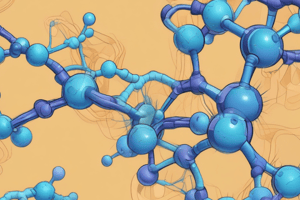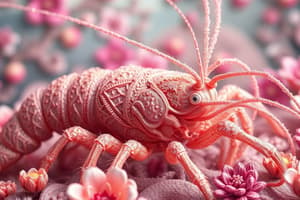Podcast
Questions and Answers
What type of structure can linear informational biopolymers form in some cases?
What type of structure can linear informational biopolymers form in some cases?
- Linear structures
- Circular structures (correct)
- Spiral structures
- Branched structures
Which of the following correctly describes the joining sites of the monomers in informational biopolymers?
Which of the following correctly describes the joining sites of the monomers in informational biopolymers?
- Both sites are identical
- There are three different joining sites
- A can join with A and B can join with B
- The 5’ phosphate can join with the 3’ OH (correct)
What is the direction of polymer growth for nucleic acids?
What is the direction of polymer growth for nucleic acids?
- To the 5’ end
- Circularly
- Bidirectional
- To the 3’ end (correct)
What element forms the backbone of nucleic acid polymers?
What element forms the backbone of nucleic acid polymers?
Which of the following best describes the asymmetry of informational biopolymer monomers?
Which of the following best describes the asymmetry of informational biopolymer monomers?
What is the typical chain length range for RNA?
What is the typical chain length range for RNA?
What is the term for the temperature at which DNA is one-half melted?
What is the term for the temperature at which DNA is one-half melted?
Nucleotides differ from each other primarily in what aspect?
Nucleotides differ from each other primarily in what aspect?
Why is the 2’ hydroxyl significant in ribose compared to deoxyribose?
Why is the 2’ hydroxyl significant in ribose compared to deoxyribose?
Which type of bond holds the two strands of DNA together?
Which type of bond holds the two strands of DNA together?
What are the two DNA strands described as in relation to their orientation?
What are the two DNA strands described as in relation to their orientation?
Which base pairs have three hydrogen bonds?
Which base pairs have three hydrogen bonds?
What happens during DNA melting?
What happens during DNA melting?
Which type of DNA structure is typically right-handed?
Which type of DNA structure is typically right-handed?
Why might DNA have a higher melting temperature?
Why might DNA have a higher melting temperature?
What is the role of DNA-binding proteins in relation to DNA?
What is the role of DNA-binding proteins in relation to DNA?
What defines the information contained within an informational biopolymer?
What defines the information contained within an informational biopolymer?
Which characteristic distinguishes informational biopolymers from other types of polymers?
Which characteristic distinguishes informational biopolymers from other types of polymers?
What is the primary role of the common element in the structure of informational biopolymers?
What is the primary role of the common element in the structure of informational biopolymers?
Why are informational biopolymers categorized as linear rather than branched?
Why are informational biopolymers categorized as linear rather than branched?
What would happen if a monomer has only one joining site in its common element?
What would happen if a monomer has only one joining site in its common element?
What type of polymers can cells create if the monomer has three joining sites?
What type of polymers can cells create if the monomer has three joining sites?
How does the linear structure of informational biopolymers benefit scientific research?
How does the linear structure of informational biopolymers benefit scientific research?
What can be inferred about the relationship between the sequence of monomers and the type of information in the polymer?
What can be inferred about the relationship between the sequence of monomers and the type of information in the polymer?
What defines the main classes of amino acids?
What defines the main classes of amino acids?
How many hydrophobic amino acids are there among the main classes of amino acids?
How many hydrophobic amino acids are there among the main classes of amino acids?
Where does the next amino acid get added in a growing protein chain?
Where does the next amino acid get added in a growing protein chain?
What form are nucleotide monomers in before being incorporated into a nucleic acid chain?
What form are nucleotide monomers in before being incorporated into a nucleic acid chain?
Which of the following is NOT a nucleoside triphosphate?
Which of the following is NOT a nucleoside triphosphate?
What happens to the outer two phosphates when a nucleoside triphosphate is incorporated into a growing chain?
What happens to the outer two phosphates when a nucleoside triphosphate is incorporated into a growing chain?
What is required for energized monomers to join a growing chain?
What is required for energized monomers to join a growing chain?
What is the role of tRNA in protein synthesis?
What is the role of tRNA in protein synthesis?
What is the primary reason that DNA has greater stability compared to RNA?
What is the primary reason that DNA has greater stability compared to RNA?
Which component is crucial for the formation of the phosphodiester bond in nucleic acids?
Which component is crucial for the formation of the phosphodiester bond in nucleic acids?
What distinguishes DNA from RNA in terms of nucleotide composition?
What distinguishes DNA from RNA in terms of nucleotide composition?
What terminus of a protein chain is responsible for the growth of the polymer?
What terminus of a protein chain is responsible for the growth of the polymer?
Which characteristic of amino acids is critical for their role in protein synthesis?
Which characteristic of amino acids is critical for their role in protein synthesis?
In terms of molecular structure, which of the following best describes the bond that links adjacent nucleotides in DNA?
In terms of molecular structure, which of the following best describes the bond that links adjacent nucleotides in DNA?
Which of the following correctly describes the polarity of a short DNA molecule?
Which of the following correctly describes the polarity of a short DNA molecule?
What role does the 5’ phosphate play in DNA synthesis?
What role does the 5’ phosphate play in DNA synthesis?
Flashcards
Amino Acid Classes
Amino Acid Classes
Amino acids are grouped into three classes based on their chemical properties: hydrophobic, hydrophilic, and special.
Hydrophobic Amino Acids
Hydrophobic Amino Acids
Hydrophobic amino acids have side chains that are nonpolar and tend to avoid water. They are often found buried within the interior of proteins.
Hydrophilic Amino Acids
Hydrophilic Amino Acids
Hydrophilic amino acids have side chains that are polar and attract water molecules. They are often found on protein surfaces.
Peptide Bond
Peptide Bond
Signup and view all the flashcards
Protein Growth Direction
Protein Growth Direction
Signup and view all the flashcards
Energized Monomers for Nucleic Acids
Energized Monomers for Nucleic Acids
Signup and view all the flashcards
Energized Monomers for Proteins
Energized Monomers for Proteins
Signup and view all the flashcards
Enzyme Catalyzed Linkage
Enzyme Catalyzed Linkage
Signup and view all the flashcards
Informational Polymer
Informational Polymer
Signup and view all the flashcards
Polymer
Polymer
Signup and view all the flashcards
Monomer
Monomer
Signup and view all the flashcards
Common Element
Common Element
Signup and view all the flashcards
Characteristic Element
Characteristic Element
Signup and view all the flashcards
Linear Polymer
Linear Polymer
Signup and view all the flashcards
Branched Polymer
Branched Polymer
Signup and view all the flashcards
Sequence
Sequence
Signup and view all the flashcards
What is DNA's structure?
What is DNA's structure?
Signup and view all the flashcards
What are the base pairing rules in DNA?
What are the base pairing rules in DNA?
Signup and view all the flashcards
How many hydrogen bonds form between each base pair?
How many hydrogen bonds form between each base pair?
Signup and view all the flashcards
What is DNA denaturation?
What is DNA denaturation?
Signup and view all the flashcards
What is DNA renaturation?
What is DNA renaturation?
Signup and view all the flashcards
What is the Tm (melting temperature) in DNA?
What is the Tm (melting temperature) in DNA?
Signup and view all the flashcards
How can DNA bind proteins?
How can DNA bind proteins?
Signup and view all the flashcards
What is the function of DNA polymerase?
What is the function of DNA polymerase?
Signup and view all the flashcards
DNA vs. RNA: 2' OH
DNA vs. RNA: 2' OH
Signup and view all the flashcards
DNA vs. RNA: Bases
DNA vs. RNA: Bases
Signup and view all the flashcards
Nucleotide Linkage
Nucleotide Linkage
Signup and view all the flashcards
DNA Polymerization Direction
DNA Polymerization Direction
Signup and view all the flashcards
Amino Acid Structure
Amino Acid Structure
Signup and view all the flashcards
Amino Acid Stereoisomers
Amino Acid Stereoisomers
Signup and view all the flashcards
Amino Acid Polymerization: Direction
Amino Acid Polymerization: Direction
Signup and view all the flashcards
Amino Acid Side Chains
Amino Acid Side Chains
Signup and view all the flashcards
Circular DNA
Circular DNA
Signup and view all the flashcards
Informational Biopolymer Monomers
Informational Biopolymer Monomers
Signup and view all the flashcards
Asymmetry in Biopolymers
Asymmetry in Biopolymers
Signup and view all the flashcards
Unidirectional Polymer Growth
Unidirectional Polymer Growth
Signup and view all the flashcards
Nucleic Acid Monomer
Nucleic Acid Monomer
Signup and view all the flashcards
5' and 3' Ends of Nucleic Acids
5' and 3' Ends of Nucleic Acids
Signup and view all the flashcards
Pentose Sugar in Nucleic Acids
Pentose Sugar in Nucleic Acids
Signup and view all the flashcards
Nucleic Acid Polymer Growth
Nucleic Acid Polymer Growth
Signup and view all the flashcards
Study Notes
Biopolymer Structure
- Biopolymers are covalent-bonded chains of monomers.
- Informational polymers have more than one monomer type.
- The order of monomers is the information (sequence).
- DNA, RNA, and protein are informational biopolymers.
Monomer Structure
- Informational biopolymer monomers have a common, generic structure with a common element shared by all monomers.
- A distinctive "characteristic" element distinguishes each monomer.
- The common element forms the backbone via covalent bonds between monomers.
- The characteristic elements form side chains.
Polymer Structure
- Polymer structure depends on monomer chemistry.
- If a monomer has one joining site, only two monomers bond. This doesn't create a polymer.
- Two joining sites allow for potentially infinite-length linear polymers.
- Three joining sites create branched polymers.
- Informational biopolymers are linear, not branched.
- Linear polymers have one 5' end and one 3' end that are chemically distinct.
- Chain growth is unidirectional.
Nucleotides
- Two major monomer units are nucleotides and amino acids.
- Nucleic acids (DNA and RNA) use nucleotides.
- Protein uses amino acids.
- The characteristic element in a nucleotide is a heterocyclic base.
- The common element that forms the polymer backbone is a pentose sugar-phosphate.
- Pentose sugars are 5-carbon sugars.
- Example: ribose in RNA, and deoxyribose in DNA.
- The joining sites are the 5' phosphate and the 3' hydroxyl group.
- Nucleic acid polymerization always adds monomers at the 3' end.
- DNA and RNA nucleotides are similar but differ in the pentose sugar. Deoxyribose lacks the 2' hydroxyl of ribose.
- Uracil (U) is found in RNA; Thymine (T) is found in DNA.
- The nucleotides also contain a phosphate group.
- Important bases: adenine (A), Guanine (G), Cytosine (C), Thymine (T).
Amino Acids
- The characteristic element in an amino acid is the side chain (R).
- The common element is a central carbon bonded to an amino group (NH2), a carboxyl group (COOH), and a hydrogen atom, and the side chain.
- Only L-amino acids are used in protein synthesis.
- Joining sites are the amino group (NH2) and the carboxyl group (COOH).
- Protein polymerization always adds monomers to the carboxyl end.
- Proteins have 20 amino acids.
- Proteins can be divided into hydrophobic, hydrophilic, and special groups based on side-chain properties.
General
-
Monomers are energized to be incorporated into polymer chains.
-
Nucleotide monomers are in the form of nucleoside triphosphates (NTPs).
-
Amino acid monomers are in the form of aminoacyl-tRNA esters, which are high energy.
-
Enzymatic catalysis is required for linking monomers. The linking reaction is catalyzed by a specific enzyme associated with a template molecule.
-
Template molecules direct enzyme action for monomer incorporation.
-
Two main template molecules for enzyme action include DNA and mRNA.
-
RNA and protein tend to be single polymer chains. DNA tends to be double-stranded.
-
DNA in a double-stranded structure can be separated and re-associated via bonds between complementary bases.
-
DNA denaturation and renaturation occurs during replication and transcription.
-
DNA denaturation is also used in experimental molecular biology and genomics.
-
The melting temperature (Tm) of DNA depends on base composition. High G-C content has a higher melting temperature.
-
DNA can bend. This is important for DNA-protein interactions and folding.
Studying That Suits You
Use AI to generate personalized quizzes and flashcards to suit your learning preferences.
Related Documents
Description
Explore the key concepts of biopolymer structure and the chemistry of monomers in this quiz. Understand how informational polymers are formed and the significance of their distinctive elements and joining sites. Test your knowledge about DNA, RNA, and the structural characteristics that define these biopolymers.




